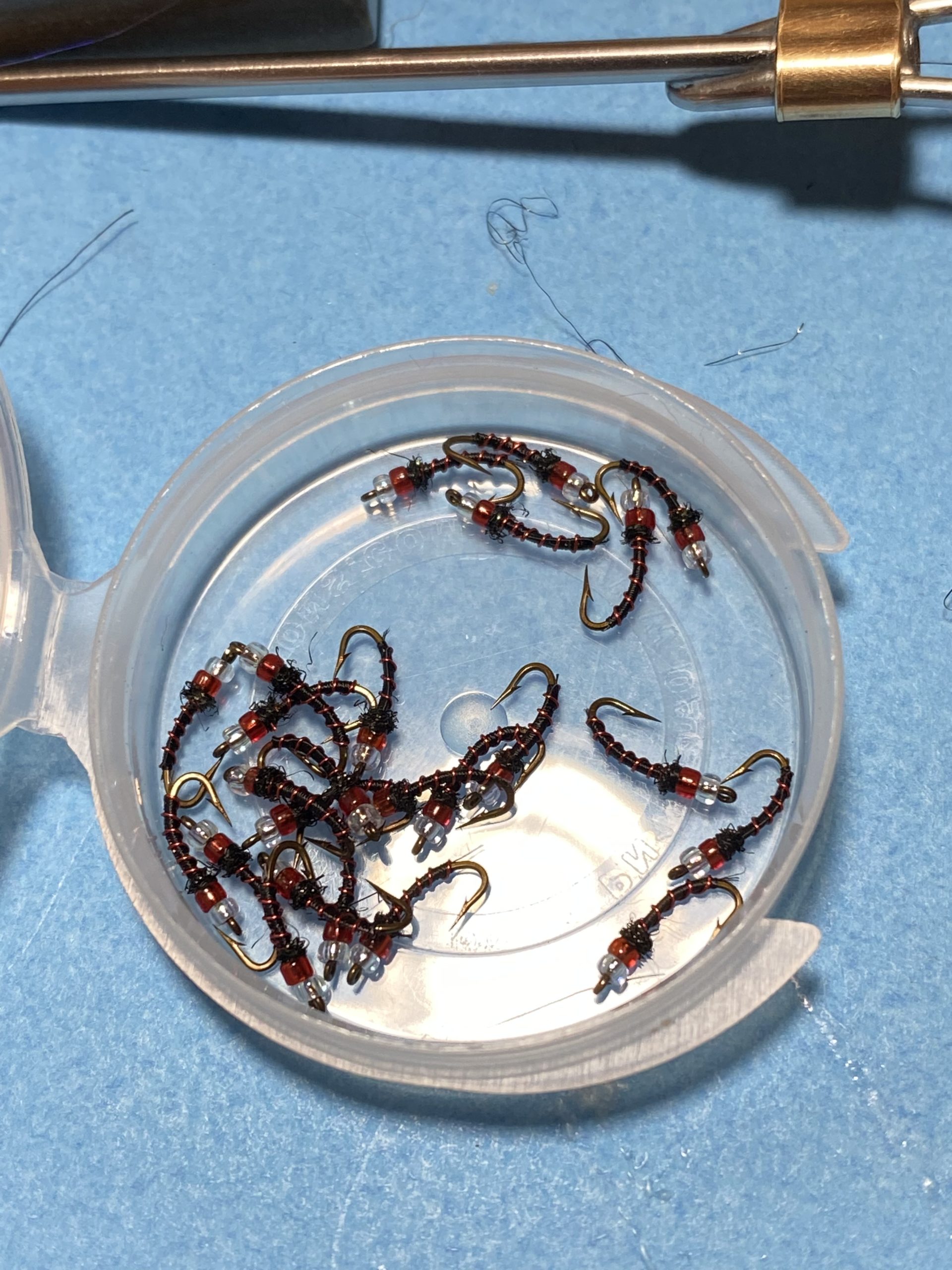
5 Winter flies for spring creeks….and some honorable mentions
By Jan D. Axtell
As a fishing guide I spend most of my spring, summer, and fall with anglers introducing them to the Paradise Valley Spring Creeks, Yellowstone River and it tributaries in Yellowstone National Park. There is not a lot of fishing for myself during these times. While I enjoy living and fishing vicariously through my clients, most of my personal fishing time on the spring creeks from late October through the spring. At this time of year the rod fees are very reasonable and there can be great surges of river run brown trout especially in the month of November and post spawn fish into December, as well as runs of rainbow trout starting in March. Late fall, winter, and early spring are great seasons to fish in relative solitude and enjoy the spring creeks on a different level. In my mind they are the most overlooked seasons in Montana trout fishing almanac.
If you are willing to dress for the Montana weather the Paradise Valley spring creeks offer exceptional late fall and winter fishing with hatches of baetis and midges that can produce some of the biggest trout of the year. This time of year nymphing the stable pools is the most productive method of catching fish. You’ll find rising fish but day in and day out it’s the nymph they eat. More specifically it’s the abundant chironomid larvae and pupae that dominate the trout’s dies.
Here are 5 of my go to winter patterns for winter nymph rigs.
The Flies
The Black and Blood Midge aka the Blood Blister Midge
The impetus for this fly was a light table photograph of a chironomid larva from a stream sample. When
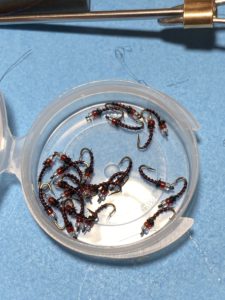
The Black & Blood Midge
back lit and viewed though a dissecting microscope you could clearly see the differentiation of the dark body and the blood. The design of this fly was to imitate that color differentiation. This fly has been remarkably successful for me not only on the Paradise Valley spring creeks, but also on Slough Creek and a number regional tailwater fisheries including the Missouri and the Big Horn Rivers.
Hook: Tiemco 200r #18-20
Bead: 1 clear opalescent followed by 1 red midge beads
Body: black thread Uni 8/0W
Tail: 1mm tag of tying thread – frayed
Rib: red extra sm wire
Collar: black ice dub
The Cheeseman Emerger
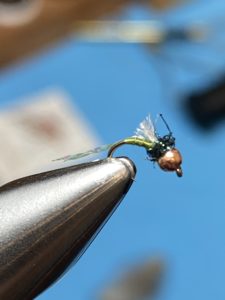
The Cheeseman Emerger
The Cheeseman Emerger was developed on Colorado’s South Platte River to approximate the baetis mayflies and midges that hatch in profusion there. I began fishing this pattern on the spring creeks during the fall winter and spring to imitate the Baetis mayfly hatches prior to emergence. In the beginning I started fishing it in olive with a black bead head, but quickly realized that it would also approximate light colored midges as well and adapted the pattern in grey, tan, red, and black. It has been a staple in my fly box ever since.
Hook: 1x curved nymph hook 20-22
Body: tying thread (read, olive, black, cream, tan) 8/0
Bead: 1mm black tungsten bead head
Tail and shellback: midge flashabou
Rib: tying thread loose wraps
Wing: white Z lon
Collar: dubbing to match bead or tying thread
Tungsten Bead-headed Sunkist nymph
Make no bones about it, this fly looks like a nymph attached to an egg. While I have mixed emotions about
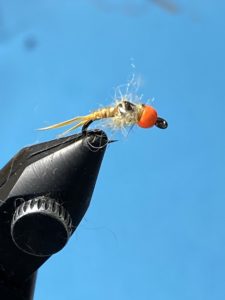
The Tungsten Sunkist Nymph
egg flies, I cannot deny that: 1) eggs are a natural food source for trout at certain times of the year, and 2) this fly catches a lot of fish. The Tungsten Bead-headed Sunkist Nymph fishes well in fast and deep water. I like to run it below spawning areas in deep stable pools- away from the reds- where fish often stage to intercept eggs being swept downstream. It’s a depth charge of a fly and gets deep quick. It has produced a number of very big fish. It is a mass-produced fly pattern by many of the major companies. We fish this nymph on both an indicator rig as well as in the European tight line rig. I cannot locate or identify the originator of this fly (kudos to you sir or ma’am – credit where credit is due), but this bad boy has snuck into my winter spring creek boxes and has no intention of leaving. Here’s the version I tie:
Hook: 2x curved nymph hook 16- 20
Bead: 2.3-3mm Hot Tungsten Bead fluorescent orange
Thread: 8/0
Tail: light Coc De Lion
Body: yellow/sulfer/pmd goose biot – a small dab of glue on the hook shank helps with the longevity of the fly
Shellback: black bug skin
Thorax bleached squirrel dubbing
Trash Can midge
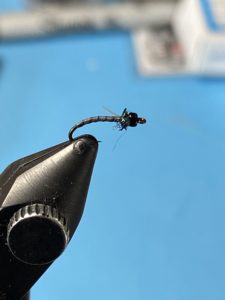
The Trash Can Midge
When it’s time to clean off my fly-tying desk I always try to make a little pile of usable materials left over from the tying session. The Trash Can midge is a fly born out of, and based on, what’s been left over and right in front of me. Its designed to imitate a pupating midge emerger. Its moderately weighted and has good movement as a result of its weighting and the flash in the wing and collar. This “Franken fly” has been producing fish, actually now that I think about it, throughout the year. A pleasant bit of serendipity.
Hook: Tiemco 200r 18-22
Bead – root beer or black glass bead
Body tying thread grey
Rib: tying thread, sharpied black and wrapped up the shank
Wing 1 strand of pearlescent flashabou cut to about 3mm in length.
Collar: thinly dubbed Ice Dub to match body, brushed out to look like legs and give it life
Bead-headed String Thing midge
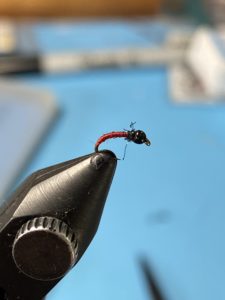
The Bead Head String Thing
This could be the easiest fly in the world to tie, and I am embarrassed to tell you how many fish it catches. Its merely thread (red, olive, black, gray) with a 1mm black tungsten bead and a collar of ice dub to match or contrast (as the mood may take you) the thread. Its just this simple. Three passes of thread up and down the hook shank starting behind the bead. On the 4th pass back up to the collar, spin the bobbin counterclockwise -this will make a rope out of the wide 8/0 thread -and make loose wraps up the hook shank to create a rib.
Hook: Tiemco 200r 18-22
Bead: 1mm black tungsten bead
Body: tying thread color to match local bugs (red, black, grey, olive, cream)
Rib: tying thread spun counterclockwise to make a rope.
Collar: ice dub (thinly dubbed to match thread)
I rig all these flies on my standard midge nymph rig for the spring creeks. The base is a 7.5’ 5x leader to which I attach 1-2’ of 5 or 6x fluorocarbon tippet. This first knot is where I add split shot. I then add my larger weighted fly (like the tungsten bead-headed Sunkist nymph or scud or sow bug or Sawyer PT) and tie 1-2′ of 6x fluorocarbon tippet to the bend of the hook and add my smaller midge larvae or pupae (like the bead headed string thing).
Early on Jacquie and Tucker Nelson advised me to use the wool New Zealand style strike indicator system, and it has paid dividends in detecting the subtle takes of winter fish. 1 set the indicator to approximately 1.-1.5x the depth of water I’m fishing. Adjust the strike indicator based on water speed and where fish are feeding relative to the bottom.
Winter is a wonderful time to fish the Paradise Valley Spring Creeks. The relative seclusion and pace of the fishing really allows you to study the water and feeding behavior. I attribute much of my spring and summer success as an angler and guide to the time I spend tramping through the snow during the winter months peering into and studying the holes, riffles, and glide sections of these amazing waters. Give it a go! These 5 flies will get you started.
Post Script:
They say the only good writing is re-writing and in editing after a particularly good day of fishing I’ve come up with some honorable mentions. After all you can never have to many flies. Here are 3 alternatives to my greatest hits. A streamer, a mayfly nymph, and a dry fly to boot.
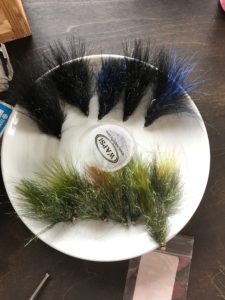
Olive & Black Sparkle Minnows
Olive Sparkle Minnow #10-14
This week Dan and I fished Armstrong’s spring creek after thoroughly nymphing a pool together we began to work upstream and down respectively. At a certain point toward the end of our day. I decided to tie on an olive sparkle minnow. I went back to where we had started and on the 2nd cast on the very same beat I had just nymphed 30 minutes prior, a very health 17” brown trout chased and ate the streamer. The next pool I fished I had the same result with a 15” fish.
This fly works everywhere (the big Yellowstone, YNP, spring creeks etc) and I always have one. Its my primary searching fly
Small Sawyer PT nymph #20-24
This fly is roughly 65 years old. Tied with slim profile is a perfectly wonderful, generalized mayfly nymph. It accounts to this day for many, many, many fish especially in early spring when the baetis mayfly hatches proliferate. All it is is pheasant tail fibers and copper wire. Don’t mess with perfection.
Haroup’s Hanging midge #20-24
This is my favorite midge dry fly invented and tied by the legendary Henry’s Fork angler/outfitter Renee Haroup. Its easy to see and the CDC makes it float like a cork. When fish are surface feeding on midges. This is my favorite pattern to start with. It floats so well you can drop a midge pupae off the hook bend. I have them in black, olive, and cream colors in my box.
0

Leave a Reply
You must be logged in to post a comment.